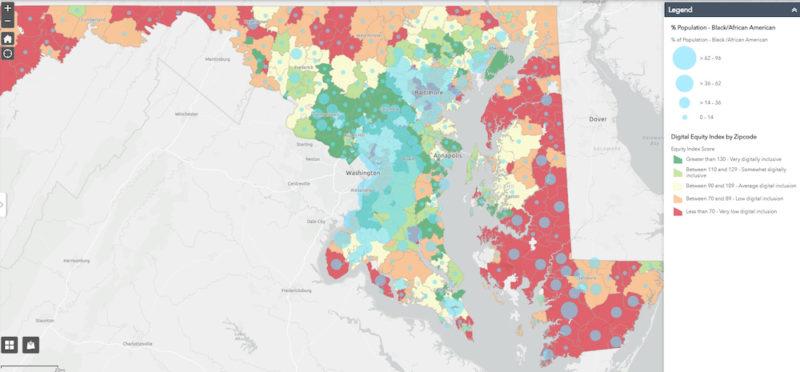Last week, the Abell Foundation announced the Maryland Digital Equity Scorecard Index Map, that illuminates disparities in access to internet and technology across ZIP codes in Maryland.
This project builds on the January 2021 report “Disconnected in Maryland: Statewide Data Show the Racial and Economic Underpinnings of the Digital Divide,” spearheaded by the Community Development Network of Maryland, the Baltimore Digital Equity Coalition and other digital equity advocates.
That report found that 520,000 Maryland households (23%) don’t have a broadband internet connection at home. Nearly 40% of the disconnected households are African American. And three-quarters of those without home internet service or a computing device live below Maryland’s median income.
The newly released scorecard comprises three indicators using data from the US Census Bureau’s American Community Survey in its index of “digital connectivity.” That is: whether a household has an internet subscription at home; whether a household is reliant only on a cellular data plan for getting online at home; and whether a household has either zero or just one computing device for accessing the internet.
The index was developed by Dr. John B. Horrigan, a senior fellow at the Illinois-based Benton Institute for Broadband & Society. The map was created by the Baltimore Neighborhood Indicators Alliance – Jacob France Institute (BNIA-JFI) team using ArcGIS, Esri’s web-based mapping software.
“We developed the map to convey, in a visual way, that the digital divide is a statewide issue, even if its character differs in rural and urban areas,” Horrigan said.

Digital equity in Maryland, according to population density. (Courtesy image)
The indicators used illustrate the range of ways a household could be digitally excluded, Horrigan told Technical.ly via email — for instance, “if you have no home wireline subscription, only have a data plan for service, and have limited access to computers, it’s hard to do online tasks such as schoolwork or telehealth,” Horrigan told Technical.ly via email. “And there is good variation in Maryland (geographically), which is nice for doing something like an index.”
The map also displays digital connectivity in conjunction with other demographic characteristics, including race and percentage of the population earning less than 200% of the average median income — one of the conditions for qualifying for the federal Affordable Connectivity Program.
“The map importantly puts Baltimore’s neighborhoods into context with the rest of the region and the rest of the state,” said Dr. Seema Iyer, who heads BNIA-JFI. “We have a lot in common with rural areas, and ideally, we’d build coalitions to address common issues. But if we look at the number of people affected by lack of access, Baltimore’s neighborhoods have much higher populations and are disproportionately persons of color, so if we take an equity lens, the needs are much higher in Baltimore.”
See the mapZIP code-level digital connectivity data shows stark differences across regions. While the state overall can cite better broadband adoptions rates than most others, Baltimore, its largest city, is more “disconnected” — with a lower home broadband adoption rate — than peers such as DC, Philadelphia and Pittsburgh, Horrigan said.
The map shows that digital equity is an issue across the state’s rural and urban areas. Whereas rural communities may face the problem of limited or lower-quality networks, urban communities may be less able to afford service from the higher-quality networks that are available, the researcher pointed out.
Though the characteristics may be different, Iyer said it’s crucial for rural and urban areas to work together to bridge the digital divide.
“What we have in common is low digital equity,” she said. “The solution in rural areas might be infrastructure vs. the urban solution might be affordability, but the problem is the same. That’s the key message from the map. We have to stop treating the problem as ‘us vs. them.'”
To entrepreneurs who want to help bridge the digital divide, the key is to deeply understand the needs of communities with lower digital connectivity, Horrigan said: “I’d encourage them to spend time in the communities where adoption rates are low and then design solutions with the needs of people in those communities in mind.”
Before you go...
Please consider supporting Technical.ly to keep our independent journalism strong. Unlike most business-focused media outlets, we don’t have a paywall. Instead, we count on your personal and organizational support.
Join our growing Slack community
Join 5,000 tech professionals and entrepreneurs in our community Slack today!

Look inside 4MLK, the University of Maryland BioPark’s new 250k-square-foot life sciences hub

Nonprofits are training AI chatbot ‘employees’ to take over tasks that cause burnout and stress

Supreme Court upholds TikTok ban, as creators and communities brace for impact


